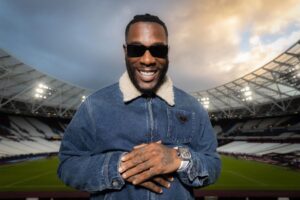Have you ever watched a movie set in the early 1900s and awed over their choice of clothing? And I do mean awed because, even then, the clothing style was very elegant, especially if you had money. From the sleek gowns and corset dresses of the Black women in 1910, to the casual suited up finish for Black men in the 1950s, all tell their own particular stories.
The story of Black fashion during those times was one of strife and determination, through which our people still knew how to look good! Of course most of the popular styles were were worn by people of all races, however we all know that Black people always bring a specific swag to everything they touch; and clothing and accessories are number one!
1910
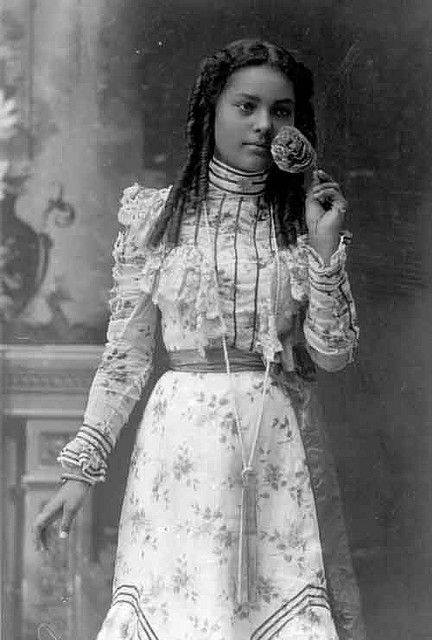
The Harlem Renaissance introduced poetry, art, music, and more from Black people. Black women were beginning to have more educational opportunities as well as access to fashionable clothing. The geographic location and socioeconomic status of the Black woman determined what kind of fashion trend boomed at that time. There was a huge backlash from white communities in response to Black people becoming wealthy and gaining a higher status. This didn’t stop anything, though, and actually gave Black men and women more confidence.
The popular clothing in 1910 for women was ruffled, full sleeved, skirts and dresses. Women wore conservative, high-necked dresses, tight corsets and necklines. Black women used their newly found freedom and wealth to buy these clothes and stand out even more.
The 20th century tea gowns which were previously considered too intimate and informal were now were considered socially acceptable to wear outside the home. If working women weren’t in uniform or workwear, they would wear two piece outfits and lacy tea dresses and evening wear with deeper necklines.
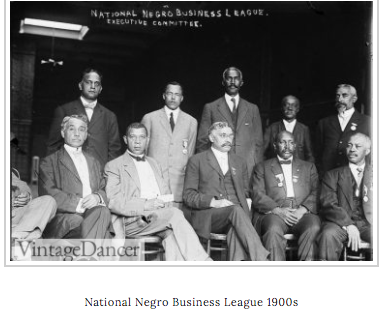
Under enslavement, white owners demanded a certain form of dress for those in bondage: better dress for house servants and managers; poorer attire for field hands, children, and those too old to continue working.
African Americans put a great deal of thought into their dress. Even today, Black people have “stepping out” clothes for social occasions, something we have been doing since the early 1900s, bringing out different outfits for church, a night out dancing, or a wedding or birthday event. Around this time, and in line with the fight for women’s rights, some women also began to wear clothes similar to men’s. They would wear shirts and ties and darker, more neutral colors.
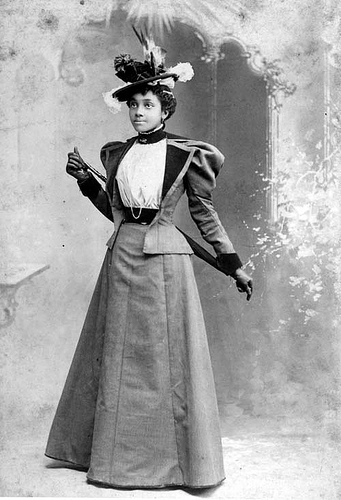
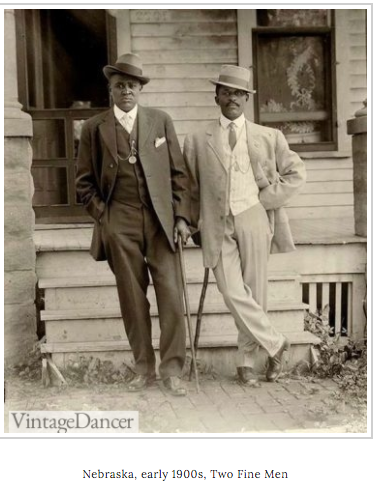
The two piece look became more popular in the 1920’s, when participating in sports such as tennis, cycling, or horseback riding.
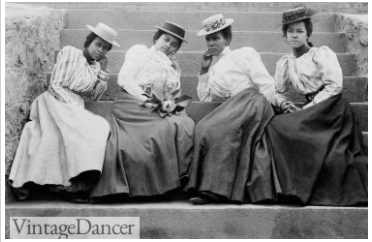
Dressing a man in the 1910s was considered the late Edwardian fashion era and it wasn’t too far off from what men wear today. This era included suits during the day, formal tailcoats for evening, and slightly more casual attire for sporting events. The younger men wore brighter colors and slimmer suits. The Edwardian era men wore sack suits which were long, plain, loose fitting (some might even say baggy) suit jackets with a one to three button closure; similar to modern suits but shorter and more fitted. Color choices were dark navy, grey, green, and brown, except that one time in 1912, when there was a trend for purple suits. The fabric was wool with striping, checkers, and plaid.
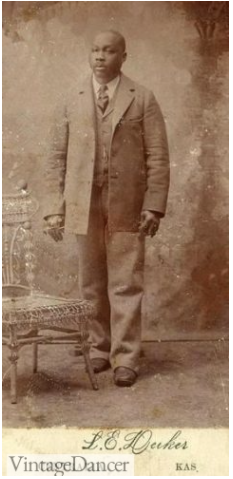
We can’t forget how popular hats were around that time, for both men and women. One of the most recognized features from early in the century are men’s hats! Felt derby and bowler hats became standard accessories for well-dressed men of the 1910s. Fedoras also became popular with flat sportsman caps and straw boater hats for the summer months.
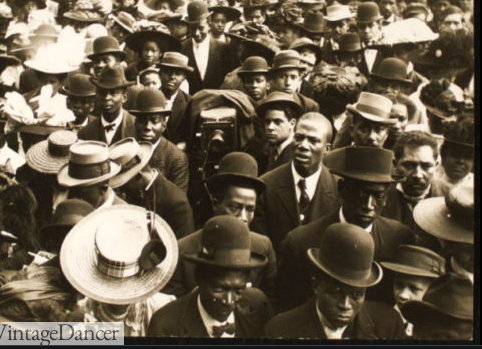
If you have access to some of your ancestors old photo albums from 1910, take a look at how they dressed. Look for details in their outfits that might tell a little tale of their lifestyles, tastes, and ages during that time.
1920s
The 1920s was the beginning of a different type of revolution and fashion played an role enormous; beginning with the Harlem Renaissance!
The Harlem Renaissance was a development of the Harlem neighborhood in New York City. It truly began in 1910 and lasted until the mid 1930s, but 1920 was the start of the battle for equal rights. They also call this the Golden Age, manifesting in literature, music and art.
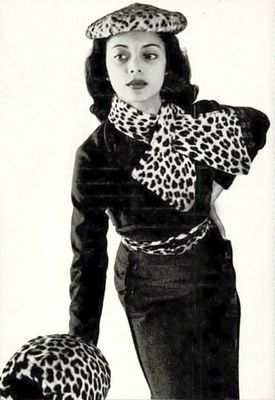
Harlem women put the sass in sassiness, wearing higher hemlines just below the knees, and smooth fabrics that were loose at the waist and helped them dance. They also wore lower-cut necklines and colorful decorated patterns. These looser, more revealing dresses were mostly worn by women who were pushing their newly found freedom.
The Harlem Renaissance launched a sense of identity through fashion for the very first time. Much like our African Ancestors, we couldn’t wait to rock bright colors like greens and golds, with feathers and shiny jewels! Female jazz vocalists would often wear elegant cocktail dresses, with large decorative earrings, shiny brooches and fur collars. Josephine Baker, one of the most successful African American performers in French history, was famous for her beautiful outfits created by fashion icons and signature soft gelled wavy hair.
In the 1920’s, women like Josephine Baker were breaking barriers as the country began to fight for equality. The Cotton Club opened in Harlem but unfortunately women entertainers were subjected to a “paper bag” test where only those whose skin color was lighter than a brown paper bag were hired.
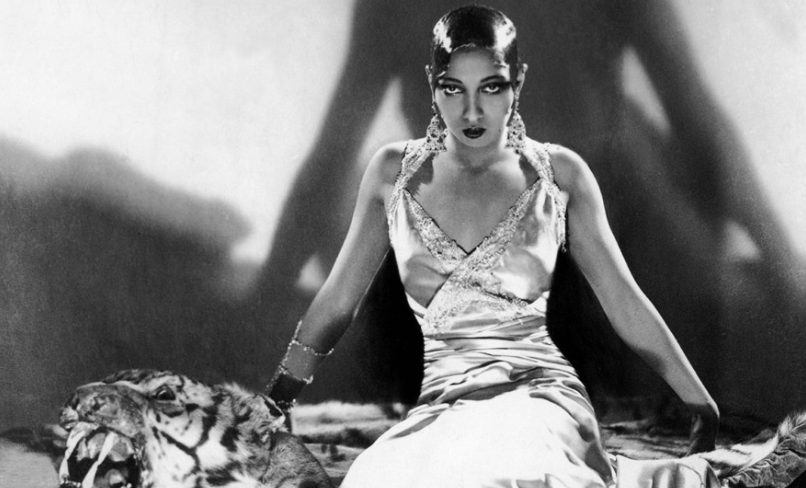
,Bessie Coleman became the first African American woman to earn a pilot’s license and also the first Black American woman to fly a plane and the first Native American woman pilot! These are just a fraction of the things that were happening during this time of fashion revolution.
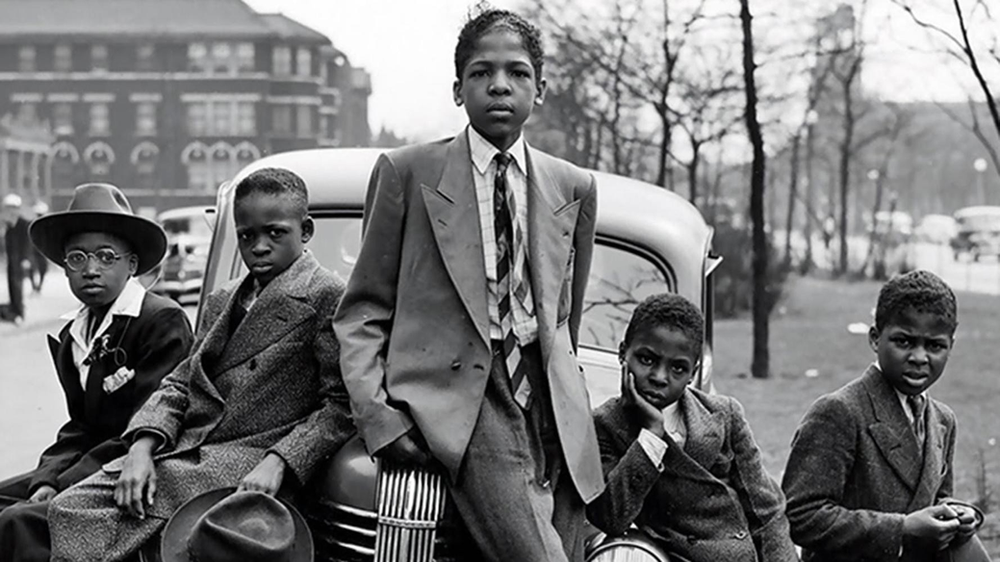
Fashion for Black men during this time was very sophisticated.
Suits were essential in a man’s wardrobe unless you were a blue collar worker, sports player, kid or college student. But, even they owned some type of suit, even if it was a hand me down or mismatched. No matter what season it was, you would still see men wearing these wool suits in the summer, dressed to impress from head to tow with two toned shoes.
Despite what the usual gangster wore in TV and movies, one color a man’s suit was not was solid black. Black suits were strictly for mourning, and wealthy gangsters would have worn only the most fashionable suits of the day and mostly imported from Europe itself.
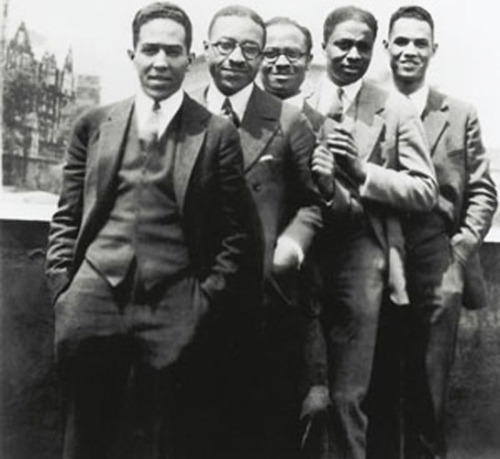
The 1920s suit fit switched up from a slim fit in the “Jazz age” (1918-1923) to a loose boxy fit after 1924.
The color of the suits were usually dark and light brown, medium blue, dark green, and grey. For the more fearless man, a pastel pink suit was an option if he wanted to catch attention. Another big change for men in the 1920s was the move from pointy shoes to more roomy designs. Oxfords were made with round or wide box tips to give the toes more room. In the second half of the 20s, Oxford designs began to get more creative, incorporating reptile skins like alligator or embossed leather.
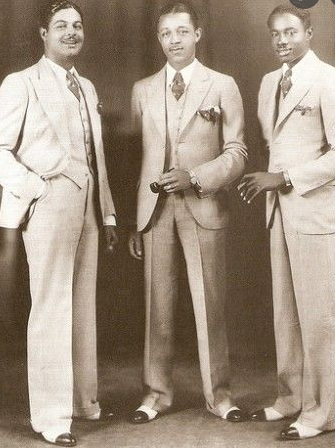
What about casual attire for men? Men usually would wear these baggy looking pants that had patterns and stripes. They would switch up the pants from wool, corduroy, and tweed fabrics in the winter to light wool, flannel and duck cloth in the summer. Dark blue denim was used for overalls and heavy-duty work pants.
Casual and colorful v-neck sweaters were worn as informal day wear. Striped shirts with white cuffs and pointed collars became popular and the soft, colorful day shirts contributed to a cool style of the unbuttoned collar.
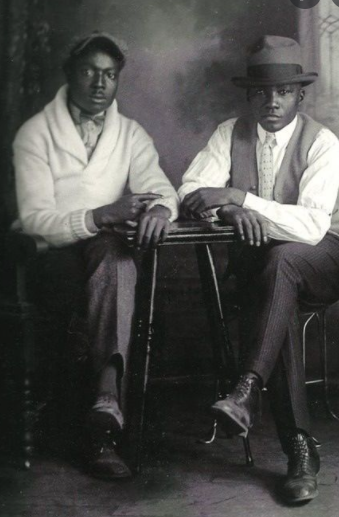
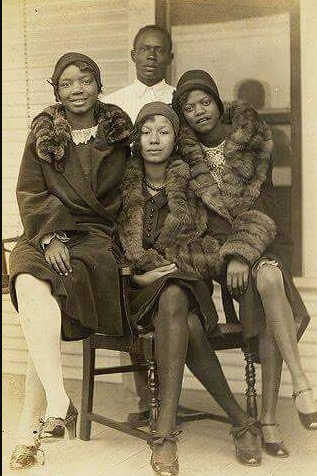
We see many outfits of the ’20s recreated today, and people especially love to wear these type of outfits for Halloween or throw Great Gatsby parties to mimic this era.
1930s
In the 1930s, fashion started copying Hollywood trends. Men’s, women’s, and children’s styles were based on fashions seen on screen with stars like Nina Mae Mckinney, Lena, ,Horne, and Stepin Fetchit among the many who directly influenced fashion.
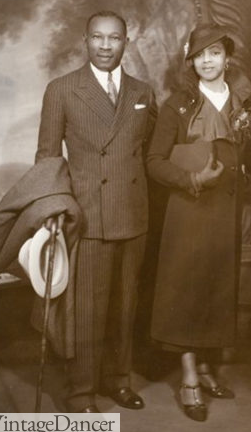
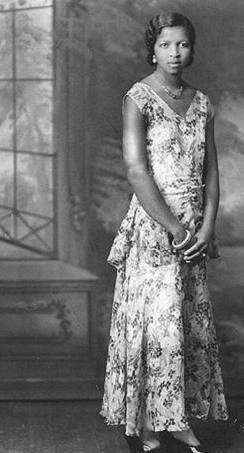
Women’s fashion matured from the more classy-casual look of the 1920s into a more feminine silhouette. Hemlines descended back to ankle length and waistlines moved back to their natural place. The clothing hugged curves and elongated the torso, keeping it romantic and dainty. Day dresses came in a variety of patterns: floral, plaid, dots, and more abstract prints. Smart suits were also popular with crisp lines and sculptural, defined shoulders created through padding. Many women all over the world attempted to emulate movie star styles in films and makeup also allowed this to happen at a small cost.
Advancements in technology helped to popularize zippers as fasteners, fitted bras with cups and the bias cut method, a process of cutting material at a 45 degree angle so that it clung to the body.
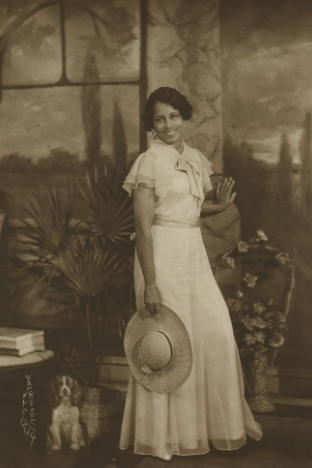
The 1930s was unfortunately famous for The Great Depression (the stock market crash in 1929 and ended at the start of World War II in 1941) and made clothing wearable from morning to night because people could no longer afford to invest in multiple outfits during the day.
There were not many women’s pants patterns as trousers weren’t worn by women, but by the mid-1930’s it was acceptable for them to be worn for sportswear. In the first part of the decade, we start to see very loosely fitted trousers. However, in the second half of the 1930s, trousers really started getting popular. As seen in the picture to the right, women dressed them up!
Dresses were worn either slightly gathered and/or pleated. The pattern for many of the early 1930s dresses that were made is known as the “cross cut bias” style. You may be familiar with this style in famous actresses photos, a type of dress that is very long, and is usually all the way down to the lower back.
Ladies Hats were also still a fundamental part of any woman’s wardrobe. Hats during this time were either wide-brimmed, crowned, or of a sailor style. Also, between 1935 and 1939 the use of a crochet “snood” and scarves were used mostly to hold the back of their hair up.
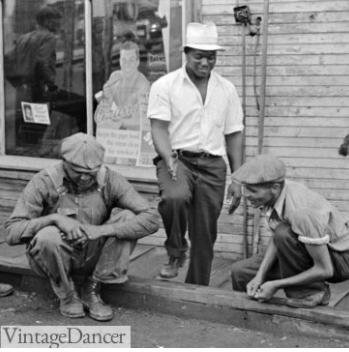
Suits were definitely still a thing for men coming into the 1930s. Both men and boys wore full three-pieced suits especially when attending formal events like a wedding. The alternative would have been something like a sweater vest and trousers.
Hats, like for women, were also still very attractive during this time. One of the most famous male hat styles of these years is the “fedora” which is a hat made of a soft material, dented lengthwise, and has a tapered rim.
The Great Depression started a trend where men’s suits would be closely cut to use less fabric and save more money. Vibrant colors were becoming unpopular so it led to shades of greys, browns, beige or light blues. These suits were fitted with single or double breasted lapels, button fastenings and wide shoulders. Businessmen could be seen wearing tapered trousers, whereas the younger gentleman would prefer flowing trousers with long coats in the zoot suit style. Buttons used to be the tradition but zippers soon became the popular alternative.
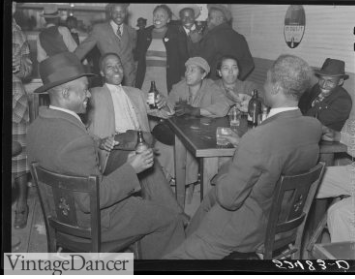
1940s
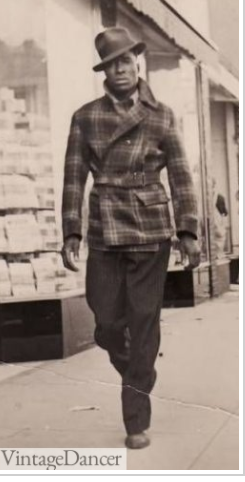
During WWII a shift in fashion occurred. There were major uniforms worn by military people, even the groom would wear his uniform at his wedding; this was true for Black and white couples.
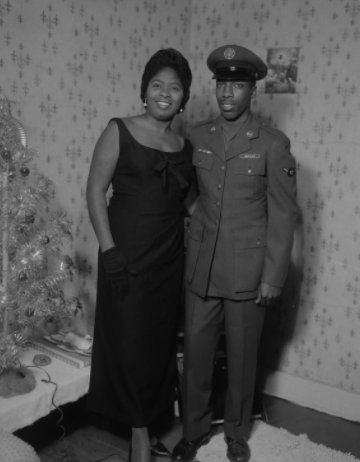
There was only a limited supply of wool during this time, starting in 1942. Instead, artificial fibers such as viscose and rayon were used; derived from wood pulp.
Ladies fur coats were available and were made from Coney ( Rabbit ) and dyed to look like Mink, Sable, Seal or Beaver. They did a lot of mending to make clothes last longer. Most of the jewelry worn during World War II was Costume Jewelry. Clothing started to be more for just covering the body than fashion. The war meant Paris and Italy were no longer fashion leaders, everyone needed practical, sturdy clothing; and no one wanted to be accused of a lack of patriotism by wearing something too flashy.
However, a new development happened; the swing era. This brought back the full-cut clothes, colorful shirts and coats, hand-painted silk ties, and double-breasted jackets and wide trousers.
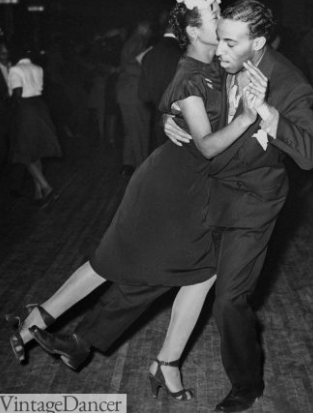
Harlem’s wide suits during this Jazz Era quickly stood out. It was even considered unpatriotic and illegal because it went so far against the standards of rationing. Also, many of the Mexican-Americans who wore it were gangsters. However, the influence was impressive on men’s fashions in the 1940s, especially Black men.
Besides being an ideal outfit to wear while jitterbugging, the high waists and boxy, roomy coats were flattering, as well as comfortable. It gave men incredible substance and they looked really good!
Even the kind of tie a man wore was crucial to his individuality. They were held in place by clips because nobody wanted to put a pin through their good tie. Shirts were held in place by cufflinks and dressed with suspenders, which fastened to the trousers by buttons. Almost everyone wore wingtip, spectator shoes, which were not too far off from the shoes they wore in the 1920s and 1930s.
There is so little high quality fashion photographs of African American women from this period, especially women that were in the military service.
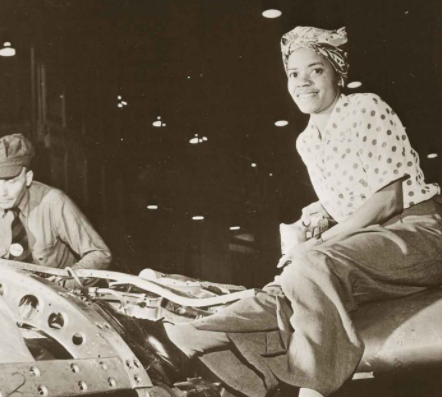
Despite whatever hardships were going on during the war, Black people still thrived and made the best of what they could. After the war in 1947- 1949, it took a while before the U.S. was able to access the same kinds of fashions that were made available in Paris, France or London, England. However, America created it’s own look.
Black men were finessing their suits and Black women were throwing on their colorful, floral dresses and heading to the nearest club to dance to the new “lindy hop” craze! Eventually white people followed suit. The Clair Mc Cardell dress became a popular fashion among women.
Styled with a V-necked bodice, flared sleeves and eight-gore style skirt with soft folds. The most memorable attribute of this historical dress is the way the stripes on either side of the dress meet and create a “W” shape around the waist as well as the bodice. A large amount of casual evening and sports wear was made after the war as well. This was fitting for people of an active lifestyle.
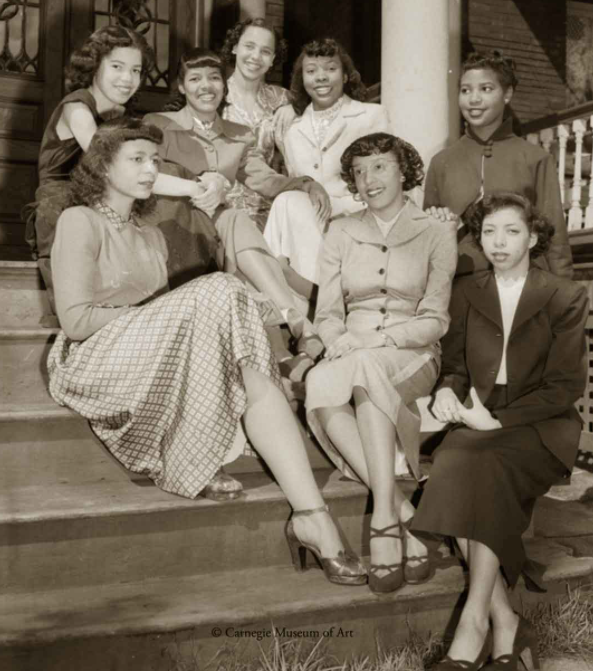
Considering how traditional things were in the 1940s, it may be hard to believe that Black people were daring and experimental with their fashion. They continued to push through the constant oppression by focusing and leading the music and fashion industry!
1950s
Segregation was ending during this era, and so the attitudes of Black women unfolded for the better.
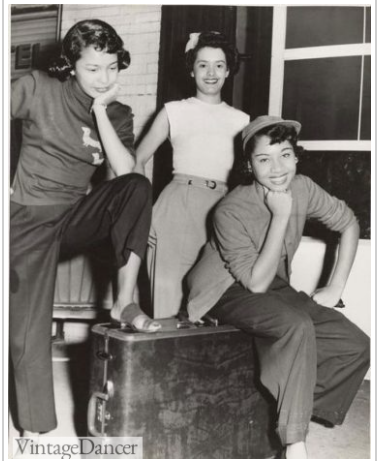
They chose styles that they wanted, whether or casual or classy. The dresses during this time changed to poodle skirts and full skirts that came to the knee. The dress bodice was fitted and corsets were still super popular. Off the shoulder cuts or strapless dresses were evolving as well.
All women were going through an independent stage, so business suits for women grew in demand. Pencil skirts, fitted and ending just below the knee, or full skirts were worn with a blouse tucked into the skirt. Maybe a nicely tailored jacket, either fitted at the waist or boxy and cropped, would be worn over the blouse. Also, Jackie Kennedy made the pillbox hat popular and women often wore this with business suits.
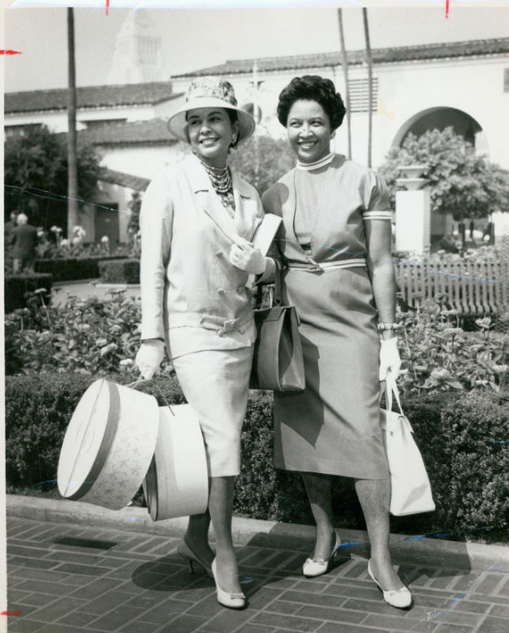
Music influenced style, and the era of the blues drifted through the Black community greatly influencing how women dressed. Black women started wearing capri-length pants, baggy shirts over fitted pants, with long earrings. Most of these kind of women wore their hair long and were called the “beat generation” or “beatnik”. They wore a lot of dark clothing and embraced change. While these women were self expressing themselves, teens were keeping it casual with rolled up capri-length jeans, sneakers, and cropped sweaters with pointed bras.
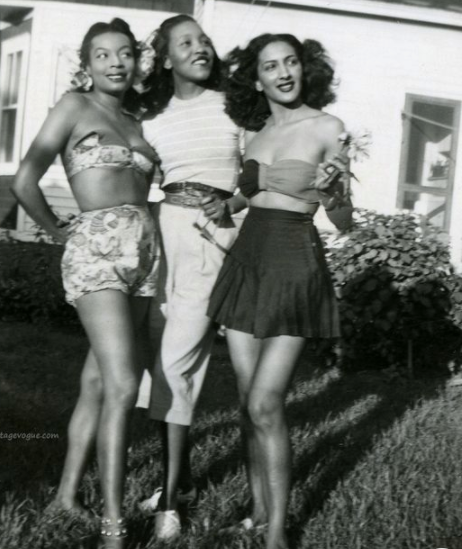
European brands were taking over the trend in America featuring looks with loose suiting, casual cuts and lines. Even denim became a huge frenzy. But it was Black men who defined ’50s cool! It was the Black men’s attitudes and talents that took classic fits of this era to another level. Black men are what made the 50’s looks hot. We see these looks in men like Sammy Davis Jr, Chuck Berry and Miles Davis.
All kinds of 1950s men’s fashions are making a comeback. Rock n’ Roll also had it’s own fashion sense. Sport coats, skinny ties, Letterman jackets, bowling shirts, saddle shoes, and chunky glasses defined the entire 1950s guy’s wardrobe. Classy men like Frank Sinatra kept the fedora hat and black and white shoes alive a little longer. Meanwhile, musician Elvis introduced trendy new suede footwear, and actor James Dean made the classic white T-shirt and leather jacket a must for any greaser. If you were a man in the 1950’s you definitely had a lot of choices.
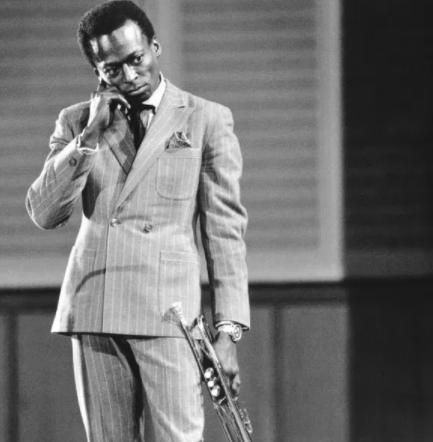
Suits were cut fuller and more comfortable making it possible for any man’s body type to look good through proper tailoring. This style trend would last until the 2000’s when tight fitting suits would gain popularity. The preppy-Ivy league look was also in during those times, but you rarely saw Black men sporting that look.
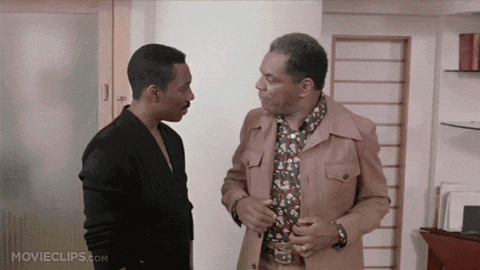
As fashion trends continue to develop throughout the years, it is clear that Black fashion carries its own swag. Through the continued struggle of injustice and independence we use the fashion world as a means of self expression and joy.

